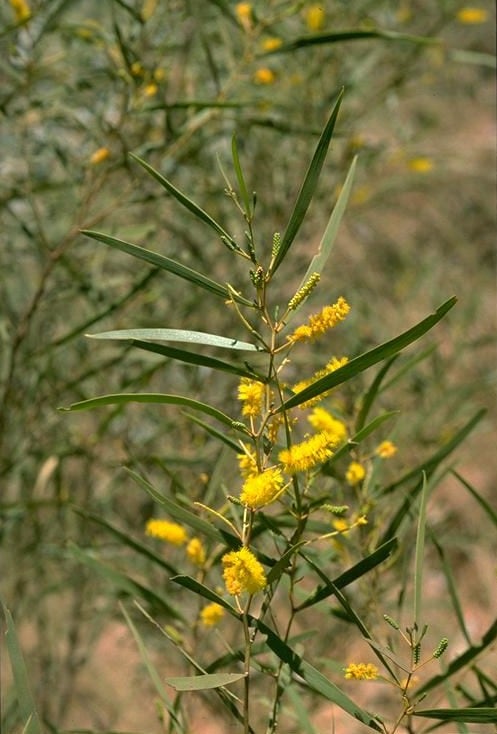Acacia ancistrocarpa Maiden & Blakely
WATTLE
Acacias of Australia
Common Name
Fitzroy Wattle, Pirraru
Family
Fabaceae
Distribution
Widespread in tropical W.A., N.T. and Qld between 17ºS and 24ºS, and W of 139ºE.
Description
Fastigiate, multi-stemmed, shrub 1.5–4 m high. Bark grey, longitudinally fissured towards base of mature stems otherwise smooth. Branchlets angular, often flexuose, pale yellowish orange or red-brown, glabrous. Phyllodes linear, or very narrowly elliptic, straight or slightly falcate, (4.5–) 6–18 cm long, (2–) 3–10 (–13) mm wide, coriaceous, somewhat shiny, bright olive-green, glabrous, with 1–3 subprominent yellowish main nerves; minor inconspicuous nerves 3 or 4 per mm, with rare anastamoses; marginalnerve discrete and yellowish; glands inconspicuous, 2 or 3, marginal. Spikes 2.5–4.5 cm long, golden; peduncles 5–15 (–25) mm long. Flowers 5-merous; calyx 0.5–0.8 mm long, dissected to 1/3, glabrous or slightly tomentose; corolla 1.5–1.8 mm long, dissected to 1/2, glabrous; ovary ±tomentose. Pods narrowly oblong or cultrate, tapered at both ends, the apex ±hooked, slightly indented or straight-sided, 6–11.5 cm long, often erect, crustaceous to subwoody, obliquely reticulate, brown to dark brown, glabrous, resinous, dehiscing elastically (valves recurved following dehiscence); seed-partitions well marked;marginal nerve thick. Seeds oblique, broadly oblong- to ±oblong-elliptic or ±ovate, 6–7 mm long, brownish black; pleurogram fine, with yellowish halo (outer band pitted); areole open, depressed.
Phenology
Flowers late Feb.–July.
Habitat
Grows usually in mallee-spinifex communities and in stony spinifex grasslands, and in shrub-steppes and along watercourses, in deep red sands and skeletal soils on lateritic plains.
Specimens
W.A.: S of Yanrey Stn turnoff, A.M.Ashby 5191 (NSW, PERTH); West Hardman R., M.Lazarides 6498 (CANB, NSW). N.T.: 16.9 miles [27.2 km] N [of] Tanami, G.Chippendale s.n. (NSW, NT5613); 4 miles [6.4 km] W of Frewena Roadhouse, Barkly Hwy, J.Must 529 (DNA, NSW). Qld: 3 miles [4.8 km] SE of Barkly Downs Stn, R.A.Perry 739 (CANB, NSW).
Notes
Usually killed by fire but regenerates profusely from seed. Used extensively in land rehabilitation in the Pilbara because it produces large quantities of seed that is easy to collect, its preference for disturbed sites and its rapid growth rate. Further details of its ecology, utilisation, etc. are given in J.W.Turnbull (Ed.), Multipurpose Austral. Trees & Shrubs 98 (1986). Details of Aboriginal use are given by P.Latz, Bushfires & Bushtucker 87 (1995).
In the Pilbara, W.A., this species commonly hybridizes with A. stellaticeps (see A. sphaerostachya) and rarely with A. citrinoviridis (see A. ancistrocarpa × citrinoviridis), A. arida and A. orthocarpa. Plants described by B.R.Maslin, Nuytsia 4: 405–407 (1983), as A. ancistrocarpa × trachycarpa are now referable to A. trachycarpa × tumida var. pilbarensis.
FOA Reference
Data derived from Flora of Australia Volumes 11A (2001), 11B (2001) and 12 (1998), products of ABRS, ©Commonwealth of Australia
Author
Dr M.D.Tindale and Dr P.G.Kodela with the assistance of M.Bedward, S.J.Davies, C.Herscovitch, D.A.Keith and/or D.A.Morrison
Edited by B.R.Maslin
This identification key and fact sheets are available as a mobile application:
URL: https://apps.lucidcentral.org/wattle/
© Copyright 2018. All rights reserved.









